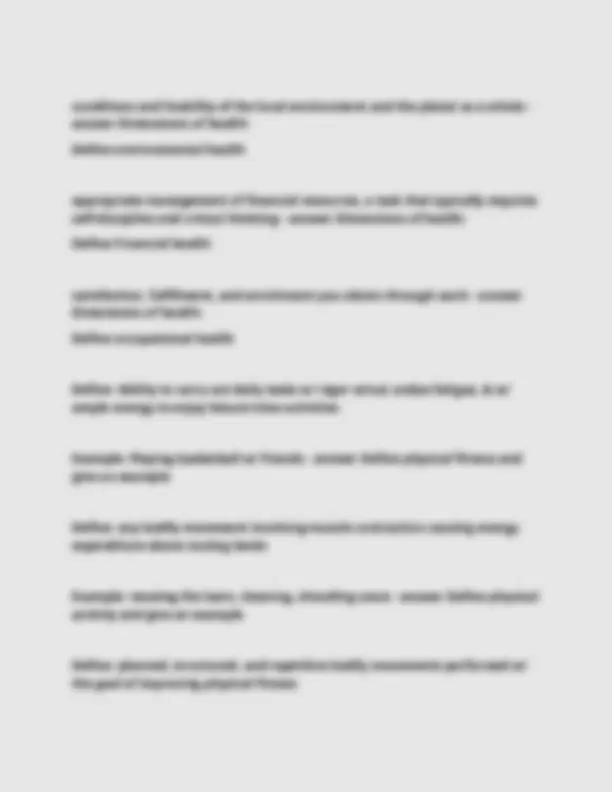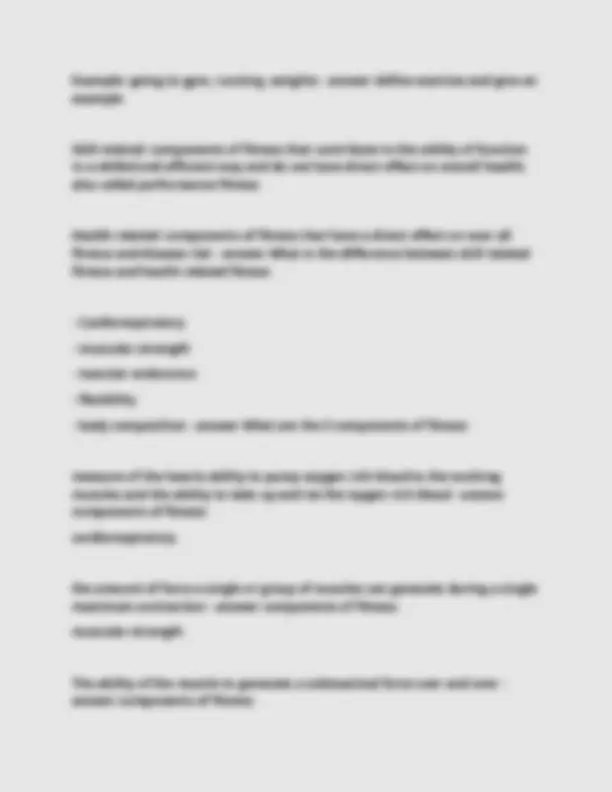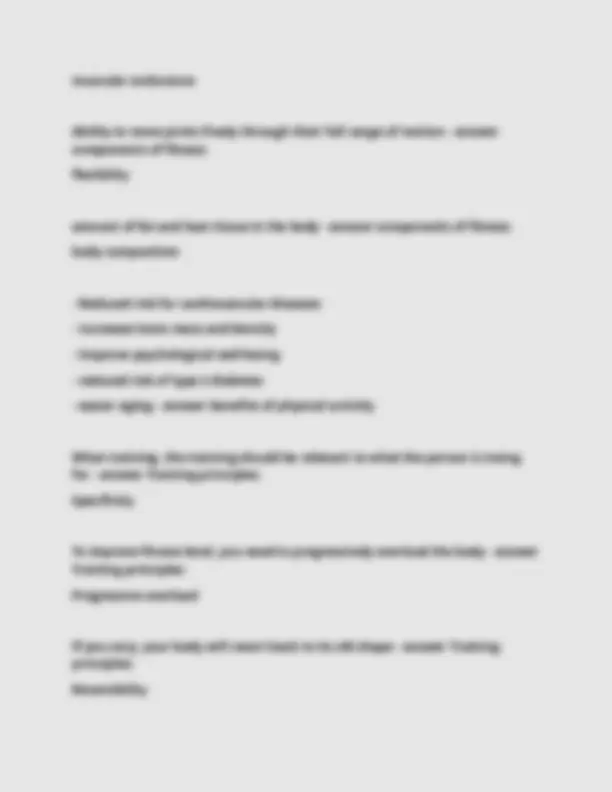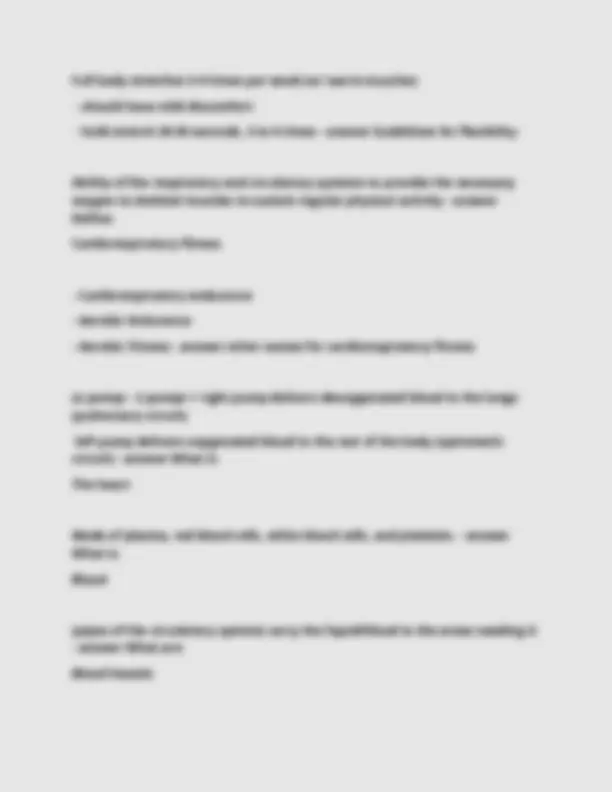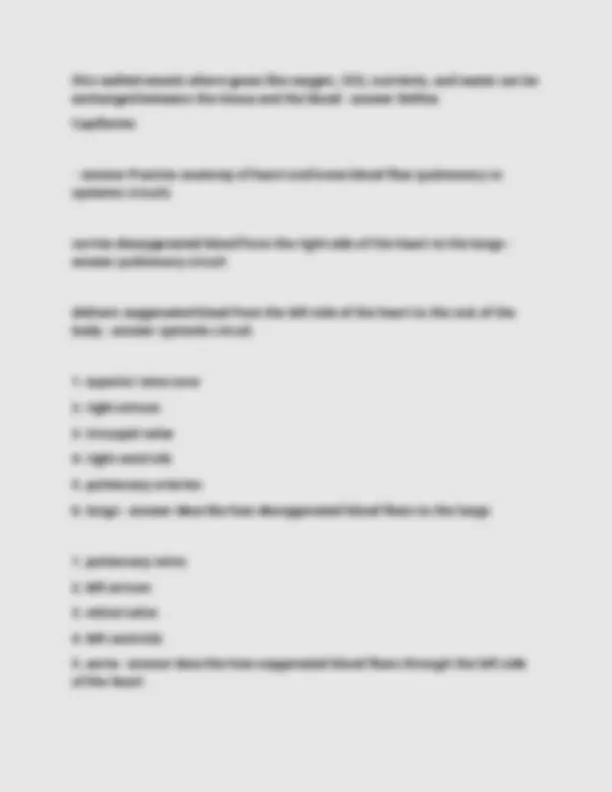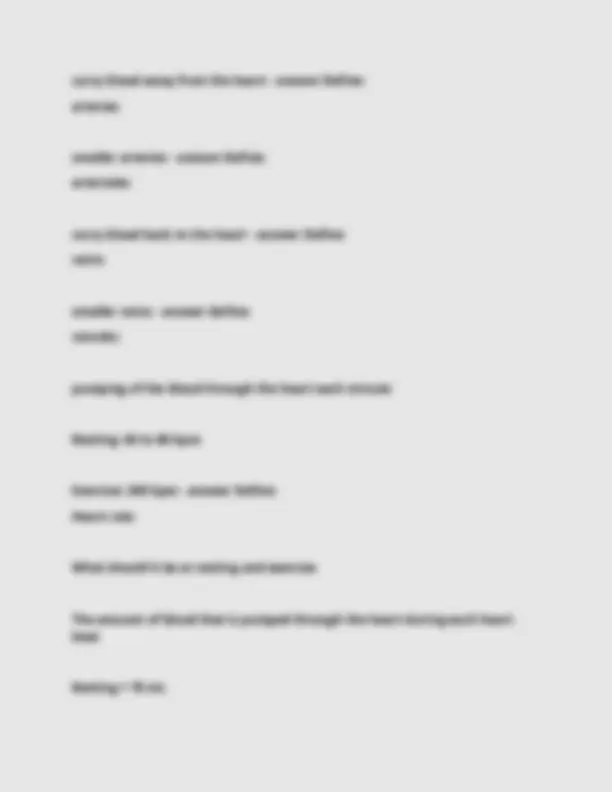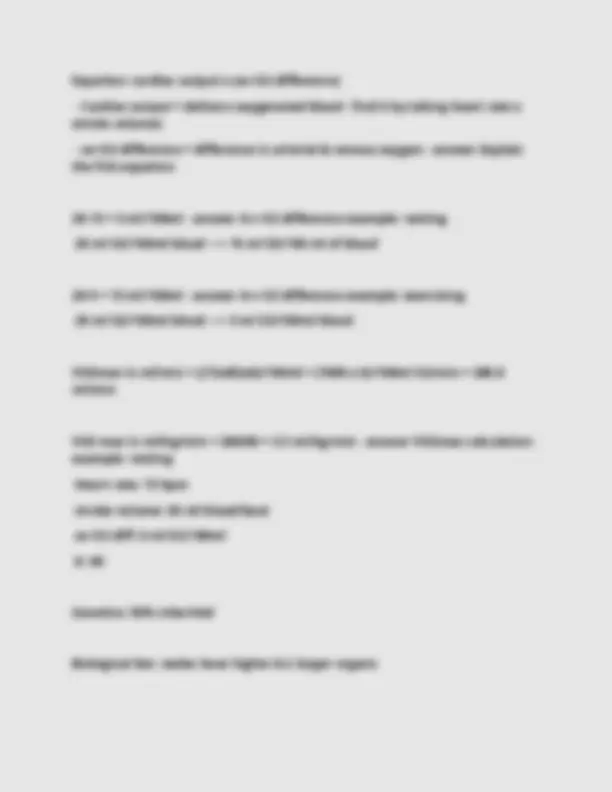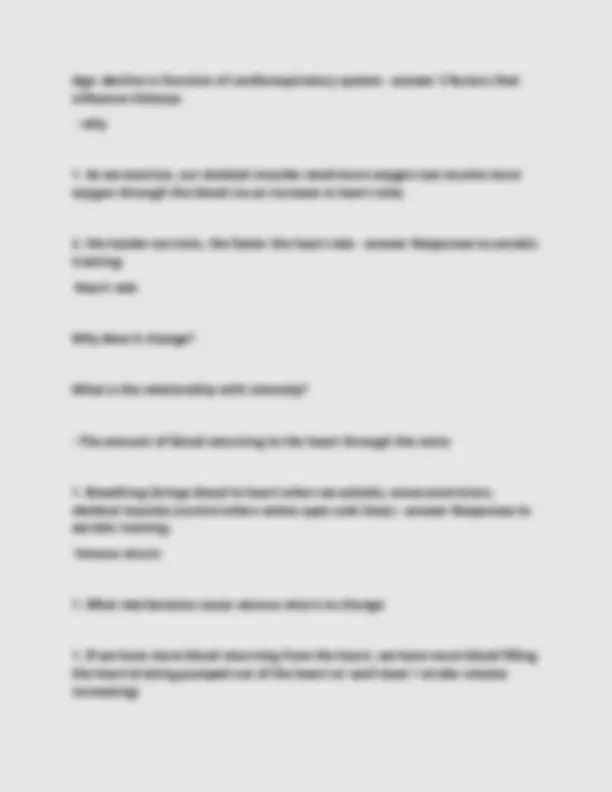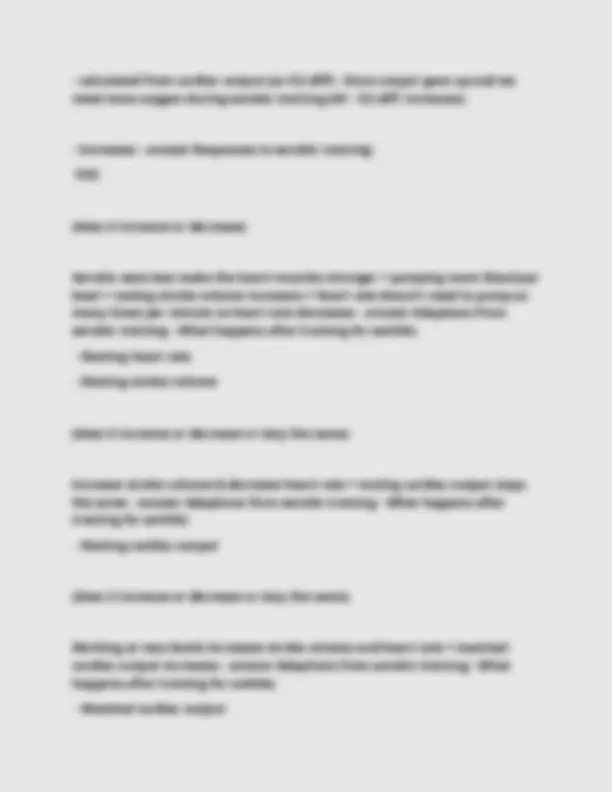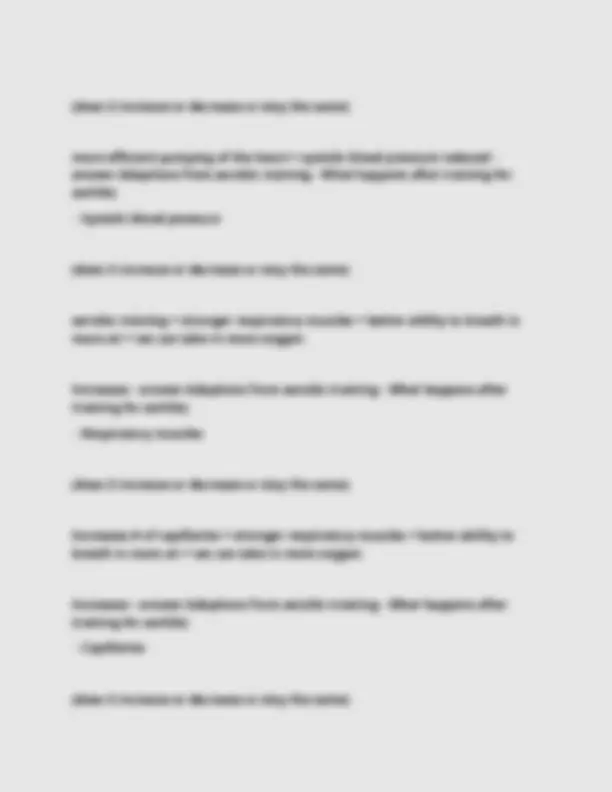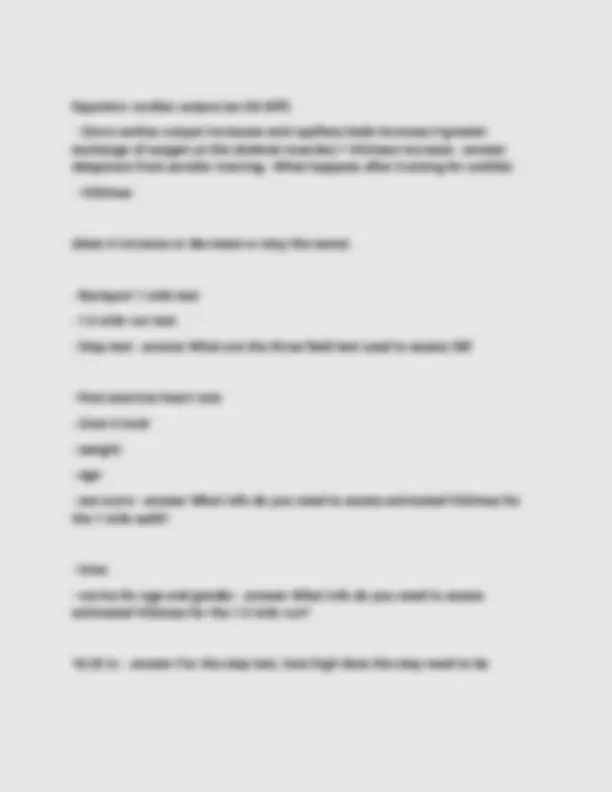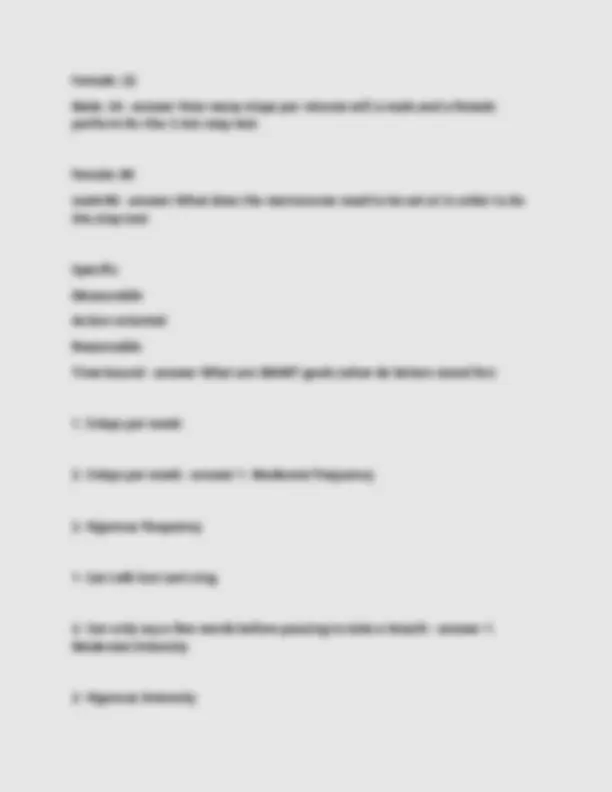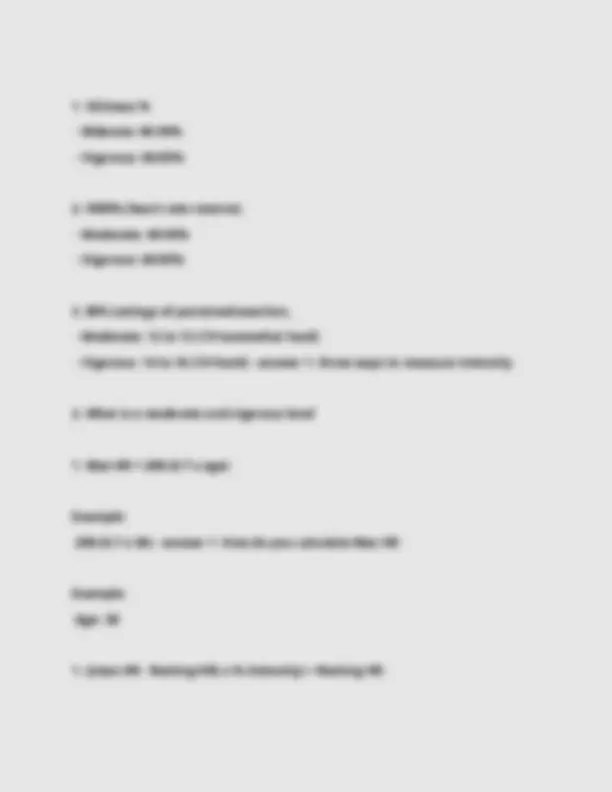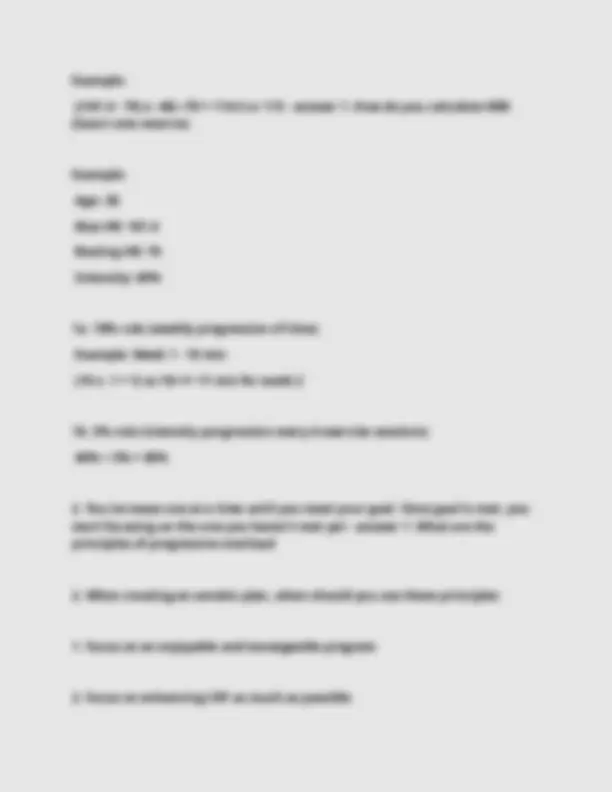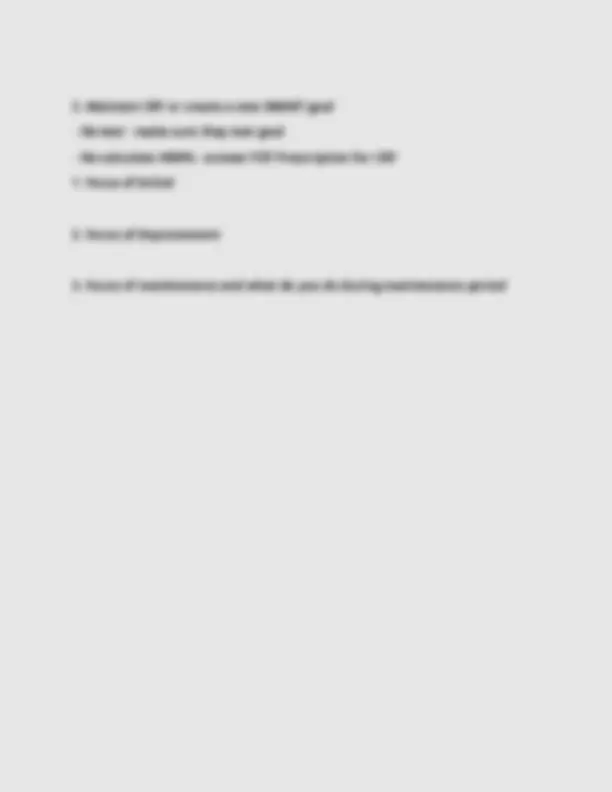Download KIN 258 - Module test with verified solutions already grad and more Exams Biology in PDF only on Docsity!
KIN 258 - Module test
with verified solutions
already graded A+
a state of complete physical, mental, and social well-being and not merely the absence of disease or infirmity - answer Define health Positive:
- enjoying life (pos. mood, high energy, sense of well being)
- withstand life's challenges Negative:
- Illness (Mono, flu)
- Disease (diabetes, heart disease)
- Premature death - answer What are some positive and negative characteristics of health an active process of adopting patterns of behavior that can improve an individuals health and perceptions of well-being and quality of life in terms of multiple intertwined dimensions - answer Define Wellness
- Physical
- Mental
- Social
- Environmental
- Spiritual
- Emotional
- Financial
- Occupational - answer What are the 8 dimension of health Complete physical condition and functioning of the body; encompasses behaviors that support health: diet, exercise, sleep, and self-care - answer Dimensions of health: Define physical health Developing and enhancing one's knowledge base and critical thinking, decision-making and problem solving skills - answer Dimensions of health: Define mental health Ability to develop and maintain positive, healthy, satisfying interpersonal relationships and appropriate support systems - answer Dimensions of health: Define social health One's ability to manage and express emotions in constructive and appropriate ways - answer Dimensions of health: Define emotional health Developing a set of values, beliefs, or principles that give meaning and purpose to life and guide one's actions and choices - answer Dimensions of health: Define spiritual health
Example: going to gym, running, weights - answer define exercise and give an example Skill related: components of fitness that contribute to the ability of function in a skilled and efficient way and do not have direct effect on overall health; also called performance fitness Health related: components of fitness that have a direct effect on over all fitness and disease risk - answer What is the difference between skill related fitness and health related fitness
- Cardiorespiratory
- muscular strength
- macular endurance
- flexibility
- body composition - answer What are the 5 components of fitness measure of the hearts ability to pump oxygen rich blood to the working muscles and the ability to take up and ise the ixygen rich blood - answer components of fitness: cardiorespiratory the amount of force a single or group of muscles can generate during a single maximum contraction - answer components of fitness: muscular strength The ability of the muscle to generate a submaximal force over and over - answer components of fitness:
muscular endurance Ability to move joints freely through their full range of motion - answer components of fitness: flexibility amount of fat and lean tissue in the body - answer components of fitness: body composition
- Reduced risk for cardiovascular diseases
- increases bone mass and density
- Improve psychological well-being
- reduced risk of type 2 diabetes
- easier aging - answer benefits of physical activity When training, the training should be relevant to what the person is traing for - answer Training principles: Specificity To improve fitness level, you need to progressively overload the body - answer Training principles: Progressive overload If you sorp, your body will revert back to its old shape - answer Training principles: Reversibility
- move from low to high intensity movements - answer Components of a workout: Warm-up
- performed to improve physical fitness
- moderate to high intensity activities - answer Components of a workout: Workout
- performed after the warm-up and workout
- brings body back to pre-workout levels
- reduced heart rate, core temp, and breathing rate
- move from medium to low intensity movements - answer Components of a workout: Cool-down (3-5 days)
- Moderate = 150 min
- Vigorous = 75 min per week - answer Guidelines for aerobic training
- Days
- min
- intensity
- 2 to 3 days
- 24 hr. rest between workouts of the same muscle group - answer Guidelines for resistance training
Full body stretches 3-4 times per week (w/ warm muscles)
- should have mild discomfort
- hold stretch 20-30 seconds, 3 to 4 times - answer Guidelines for flexibility Ability of the respiratory and circulatory systems to provide the necessary oxygen to skeletal muscles to sustain regular physical activity - answer Define: Cardiorespiratory fitness
- Cardiorespiratory endurance
- Aerobic Endurance
- Aerobic Fitness - answer other names for cardiorespiratory fitness (a pump) - 2 pumps = right pump delivers deoxygenated blood to the lungs (pulmonary circuit) left pump delivers oxygenated blood to the rest of the body (systematic circuit) - answer What is: The heart Made of plasma, red blood cells, white blood cells, and platelets. - answer What is: Blood (pipes of the circulatory system) carry the liquid/blood to the areas needing it
- answer What are: Blood Vessels
carry blood away from the heart - answer Define: arteries smaller arteries - answer Define: arterioles carry blood back to the heart - answer Define: veins smaller veins - answer Define: venules pumping of the blood through the heart each minute Resting: 60 to 80 bpm Exercise: 200 bpm - answer Define: Heart rate What should it be at resting and exercise The amount of blood that is pumped through the heart during each heart beat Resting = 70 mL
Exercise = 200mL - answer Define: stroke volume What should it be at resting and exercise Amount of blood pumped through the heart each minute Cardiac output = heart rate x stroke volume resting = 60 x 70 = 4200mL/min = 4.2 L Exercising = 180 x 111 = 20000 mL = 20L - answer Define: cardiac output How do you find it What should it be at resting and exercise the amount of pressure that is exerted on the arterial walls. when blood is pumped out of the 4 chambers, pressure develops and can be measured Systolic blood pressure: reps the pressure exerted on the arteries during contraction of the heart
- ATP : carbs, fats, and proteins
- Carbohydrates : glucose
- Fats : triglycerides
- Proteins : amino acids - answer 4 energy sources used for muscle movement and what it breaks down to
- ATP - CP (anaerobic - no oxygen in muscle)
- (0-10s) activities
- high to very high intensity
- Glycolysis (anaerobic)
- (10s-2min)
- medium to high
- Oxidative
- (over 2 min)
- low to moderate - answer 1. Name the three energy systems in the body that can produce ATP
- Tell length of exercise and intensity needed The max amount of oxygen that can be consumed and used by skeletal muscles - answer Define VO2max the absolute amount (or Volume) of Oxygen that can be consumed by an individual - answer Define VO
Equation: cardiac output x (av-O2 difference)
- Cardiac output = delivers oxygenated blood - find it by taking heart rate x stroke volume)
- av-O2 difference = difference in arterial & venous oxygen - answer Explain the fick equation 20-15 = 5 ml/100ml - answer A-v O2 difference example: resting 20 ml O2/100ml blood ---> 15 ml O2/100 ml of blood 20-5 = 15 ml/100ml - answer A-v O2 difference example: exercising 20 ml O2/100ml blood ---> 5 ml O2/100ml blood VO2max in ml/min = ((72x65)x6)/100ml = (7680 x 6)/100ml O2/min = 280. ml/min VO2 max in ml/kg/min = 280/80 = 3.5 ml/kg/min - answer VO2max calculation example: resting Heart rate: 72 bpm stroke volume: 65 ml blood/beat av-O2 diff: 6 ml O2/100ml K: 80 Genetics: 50% inherited Biological Sex: males have higher b/c larger organs
- Filling the ventricles w/ more blood increases the pressure w/in the chamber & stretches the cardiac muscles more allowing for a greater release of the blood Increases - answer Responses to aerobic training: Stroke volume
- How does venous return influence stroke volume
- Frank-starling mechanism (does it increase or decrease) (stroke volume x heart rate) when stroke volume increases and heart rate increases, then output increases increases - answer Responses to aerobic training: Cardiac output (does it increase or decrease) Skeletal muscles: Vasodilation occurs because we want blood flow to increase (Increase in vasodilation = increase in blood flow and decrease pressure)
Other organs: Vasoconstriction occurs b/c blood is being pushed away from them so the muscles get it (Increase in vasoconstriction = decrease in blood flow and increase in pressure) - answer Responses to aerobic training: Arterial dilation and vasoconstriction
- Skeletal muscle
- Other organs (does it increase or decrease)
- a) The increased filling of the ventricles during exercise (increase in blood), increases pressure in the chamber = more blood pumping b) vasoconstriction
- Increases - answer Responses to aerobic training: Systolic blood pressure
- What causes blood pressure to change (does it increase or decrease)
- Increases b/c you have an increased demand for oxygen & increased demand to remove excess CO2 - answer Responses to aerobic training: Breathing rate (does it increase or decrease)
(does it increase or decrease or stay the same) more efficient pumping of the heart = systolic blood pressure reduced - answer Adaptions from aerobic training - What happens after training for awhile)
- Systolic blood pressure (does it increase or decrease or stay the same) aerobic training = stronger respiratory muscles = better ability to breath in more air = we can take in more oxygen Increases - answer Adaptions from aerobic training - What happens after training for awhile)
- Respiratory muscles (does it increase or decrease or stay the same) Increases # of capillaries = stronger respiratory muscles = better ability to breath in more air = we can take in more oxygen Increases - answer Adaptions from aerobic training - What happens after training for awhile)
- Capillaries (does it increase or decrease or stay the same)
Equation: cardiac output (av-O2 diff)
- Since cardiac output increases and capillary beds increase (=greater exchange of oxygen at the skeletal muscles) = VO2max increase - answer Adaptions from aerobic training - What happens after training for awhile)
- VO2max (does it increase or decrease or stay the same)
- Rockport 1 mile test
- 1.5 mile run test
- Step test - answer What are the three field test used to assess CRF
- Post exercise heart rate
- time it took
- weight
- age
- sex score - answer What info do you need to assess estimated VO2max for the 1 mile walk?
- time
- norms for age and gender - answer What info do you need to assess estimated VO2max for the 1.5 mile run? 16.25 in. - answer For the step test, how high does the step need to be

